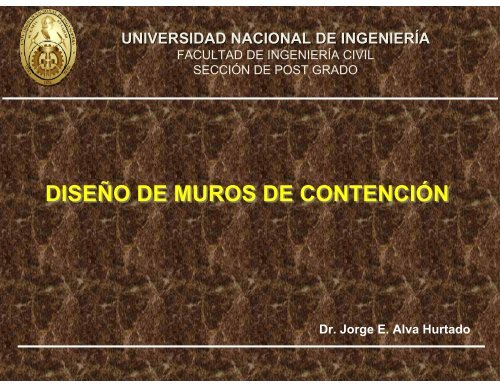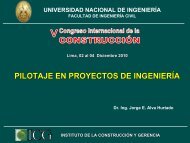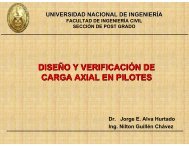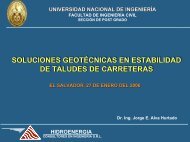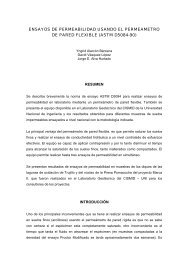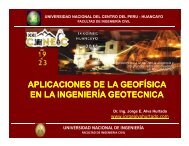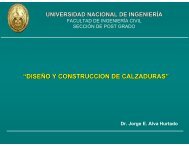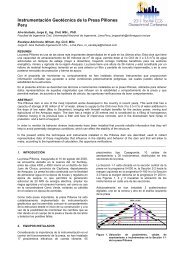diseño de muros de contención - Dr. Ing. Jorge Elias Alva Hurtado
diseño de muros de contención - Dr. Ing. Jorge Elias Alva Hurtado
diseño de muros de contención - Dr. Ing. Jorge Elias Alva Hurtado
You also want an ePaper? Increase the reach of your titles
YUMPU automatically turns print PDFs into web optimized ePapers that Google loves.
UNIVERSIDAD NACIONAL DE INGENIER<br />
UNIVERSIDAD NACIONAL DE INGENIERÍA<br />
FACULTAD DE INGENIERÍA CIVIL<br />
SECCIÓN DE POST GRADO<br />
DISEÑO DE MUROS DE CONTENCIÓN<br />
<strong>Dr</strong>. <strong>Jorge</strong> E. <strong>Alva</strong> <strong>Hurtado</strong>
MUROS DE CONTENCIÓN<br />
USO DE MUROS DE CONTENCIÓN<br />
CLASIFICACIÓN<br />
DISEÑO DE MUROS DE CONTENCIÓN<br />
Información General<br />
Condiciones <strong>de</strong> Terreno<br />
Cargas<br />
DISEÑO DE MUROS DE GRAVEDAD<br />
DISEÑO DE MUROS CANTILEVER<br />
DISEÑO DE MUROS CON CONTRAFUERTES<br />
ESTABILIDAD DE MUROS DE CONTENCIÓN<br />
DRENAJE
INTRODUCCIÓN<br />
Los <strong>muros</strong> <strong>de</strong> <strong>contención</strong> son estructuras que proporcionan<br />
estabilidad al terreno natural u otro material cuando se modifica su<br />
talud natural. Se utiliza como soporte <strong>de</strong> rellenos, productos<br />
mineros y agua.<br />
Los tipos <strong>de</strong> <strong>muros</strong> <strong>de</strong> <strong>contención</strong> son:<br />
Gravedad, utiliza su propio peso para estabilidad<br />
Cantilever, <strong>de</strong> concreto reforzado, utiliza la acción <strong>de</strong><br />
cantilever, para retener el suelo<br />
Contrafuerte, similar a cantilever, pero cuando el muro es<br />
alto o existen altas presiones <strong>de</strong> tierra. El<br />
contrafuerte está sujeto a tensión
Apoyado, similar a contrafuerte, con apoyo en la<br />
parte <strong>de</strong>lantera, trabaja a compresión<br />
Entramado, constituido por elementos prefabricados <strong>de</strong><br />
concreto, metal o ma<strong>de</strong>ra<br />
Semigravedad, <strong>muros</strong> intermedios entre gravedad y cantilever<br />
Los estribos <strong>de</strong> puentes son <strong>muros</strong> <strong>de</strong> <strong>contención</strong> con alas <strong>de</strong><br />
extensión para sostener el relleno y proteger la erosión<br />
Los <strong>muros</strong> <strong>de</strong> <strong>contención</strong> <strong>de</strong>ben ser diseñados para resistir el<br />
volteo, <strong>de</strong>slizamiento y ser a<strong>de</strong>cuados estructuralmente.
La terminología utilizada es:<br />
Relleno<br />
Cuerpo<br />
Base o cimentación<br />
Pie <strong>de</strong> base<br />
Talón <strong>de</strong> base<br />
Llave<br />
Inclinación <strong>de</strong> muro
(b)<br />
Counterforts<br />
(a)<br />
Stretcher<br />
(c) (d)<br />
Keys<br />
(e) (f)<br />
Hea<strong>de</strong>rs<br />
Approach siab<br />
Approach<br />
fill<br />
Face of wall<br />
Note : Cells to be<br />
filled with soil<br />
Optional<br />
piles<br />
Figure 12-1 Types of retaining walls. (a) gravity walls of stone masonry, brick or plain concrete. Weight provi<strong>de</strong>s<br />
overturning and sliding stability; (b) cantilever wall; (c) counterfort, or buttressed wall. If backfill covers<br />
counterforts, the wall is termed a counterfort; (d) crib wall; (e) semigravity wall (small amount of steel reinforcement<br />
is used); (f) bridge abutment
Cut<br />
(c)l<br />
High water<br />
level<br />
Fill<br />
Water<br />
(d)<br />
(a)<br />
(b)<br />
Fill<br />
Cut<br />
Water<br />
(f) (g)<br />
Figure 3.22 Common use of retaining wall : (a) Hill si<strong>de</strong> roads<br />
(b) Elevated and <strong>de</strong>pressed roads, (c) Load scaping<br />
(d) Canals and locks (e) Erosión protection (f) Flood walls<br />
(g) Bridge abutment.<br />
Fill<br />
Cut<br />
(e)
Toe<br />
Front<br />
face<br />
Batter<br />
Key<br />
Backfill<br />
Backface<br />
Key between successive<br />
concrete pours for high<br />
walls<br />
Stem<br />
Base, base slab or footing<br />
Heel<br />
Figure 12-2 Principal terms used with retaining walls.
DIMENSIONAMIENTO DE MUROS DE CONTENCIÓN<br />
El <strong>diseño</strong> se inicia con la selección <strong>de</strong> dimensiones tentativas, las<br />
cuales se analizan por requerimientos <strong>de</strong> estabilidad y estructurales,<br />
revisándose luego las dimensiones. Este un proceso <strong>de</strong> iteraciones<br />
sucesivas, que se optimiza mediante programas <strong>de</strong> cómputo.<br />
Muros Cantilever<br />
Muros con Contrafuertes<br />
Muros <strong>de</strong> Gravedad
Below frost <strong>de</strong>pth<br />
and seasonal<br />
volume change<br />
200 mm minimum<br />
(300 mm preferable)<br />
Minimum batter<br />
B/3<br />
48<br />
1<br />
H/12 to H/10<br />
B = 0.4 to 0.7 H<br />
Figure 12-3 Tentative <strong>de</strong>sign dimensions for a cantilever retaining wall<br />
H
H<br />
48<br />
200-300 mm<br />
1<br />
min<br />
H H<br />
to<br />
14 12<br />
B = 0.4 – 0.7 H<br />
0.3-0.6 H<br />
200 mm minimum<br />
Figure 12-4 Tentative <strong>de</strong>sign dimensions for a counterfort retaining wall.<br />
Depth of base should be a<strong>de</strong>quate for frost and below soils<br />
which un<strong>de</strong>rgo volume change. This wall may not be economical<br />
unless H ≥ 6 to 7 m.
H<br />
May be<br />
sloped<br />
Minimum<br />
batter<br />
1:48<br />
½ D to D<br />
0.30 m to H/12<br />
D<br />
0.5 to 0.7 H<br />
H/8 to H/6<br />
(a) (b)<br />
Slope change<br />
to reduce<br />
concrete<br />
Figure 12-5 (a)Tentative dimensions for a gravity retaining wall; (b)<br />
broken-back retaining wall.
H<br />
R<br />
R<br />
K o γ H<br />
Figure 12-6 Pressure diagram for very rigid retaining walls. If some<br />
lateral movement can take place the resultant R can be<br />
placed at 1/3 point; with no movement place R at ½<br />
point. Note use of K o , not K a .
ESTABILIDAD DE MUROS<br />
Se <strong>de</strong>be proporcionar un a<strong>de</strong>cuado factor <strong>de</strong> seguridad contra el<br />
<strong>de</strong>slizamiento. El empuje pasivo <strong>de</strong>lante <strong>de</strong>l muro pue<strong>de</strong> omitirse si<br />
ocurrirá socavación.<br />
Se pue<strong>de</strong> utilizar llaves en la cimentación para aumentar la<br />
estabilidad . La mejor localización es en el talón.<br />
FS s =<br />
FS v =<br />
suma <strong>de</strong> fuerzas resistentes<br />
suma <strong>de</strong> fuerzas actuantes<br />
suma <strong>de</strong> momentos resistentes<br />
suma <strong>de</strong> momentos actuantes<br />
≥ 1.5-2.0<br />
≥ 1.5-2.0
2<br />
1 γ Hp Kp = Pp 2<br />
This soil may<br />
be removed<br />
H p<br />
F r = R tan φ’ + c’B + P p<br />
W c<br />
a<br />
P v<br />
P h<br />
W s<br />
β<br />
b c<br />
B<br />
F r<br />
e<br />
R = Ws + Wc + Pv d<br />
H’<br />
F =<br />
β<br />
β<br />
F r<br />
P h<br />
P a =<br />
1<br />
2 γH’2 K a<br />
Ph = Pa cos β<br />
Pv = Pa cos β<br />
Ws = weight of abcd<br />
Wc = weight of concrete of entire wall system<br />
Figure 12-7 Forces involved in the sliding stability of a retaining wall.<br />
≥ 1.5
P<br />
H p<br />
2<br />
Pp = ½ γ Hp Kp<br />
Possible passive<br />
soil failure<br />
Pp<br />
a<br />
(a)<br />
Vertical stem steel<br />
Run some of the stem steel<br />
through base into key when<br />
key is located here<br />
Friction and<br />
cohesion<br />
Heel key<br />
b<br />
located here<br />
Possible slip along this<br />
inclined plane<br />
(c)<br />
P h<br />
This may happen<br />
Figure 12-8 Stability against sliding using a base key . (a) Base key near<br />
stem so that stem steel may be run into the key; but (b) the<br />
sliding surface may <strong>de</strong>velop as shown here where little aid is<br />
gained from using the key; (c) heel key which presents two<br />
possible mo<strong>de</strong>s of failure (passive and slip along the plane).<br />
L<br />
(b)<br />
L’ ∼ L<br />
L’
400<br />
3000<br />
200<br />
100<br />
0<br />
a, meters<br />
0.61<br />
Example: φ = 30° ka = 0.33<br />
H = 6; take (a+b) = 0.5H = 3<br />
Enter chart with H2 1.22 1.83<br />
kg = 132 and<br />
read horizontally to b = 2.10<br />
a= 0.9 These dimensions may<br />
be used for the first trial.<br />
37.2<br />
a = H2 k g<br />
4 (m+b)<br />
+<br />
m = 1<br />
m = 2<br />
b<br />
2<br />
–<br />
3<br />
4<br />
b 2<br />
(m+b)<br />
b = 12' (3.67 m)<br />
b = 12' (3.67 m)<br />
b = 10' (3.05 m)<br />
b = 10' (3.05 m)<br />
b = 8' (2.44 m)<br />
b = 8' (2.44 m)<br />
b = 6' (1.83 m)<br />
b = 6' (1.83 m)<br />
b = 4' (1.22 m)<br />
b = 4' (1.22 m)<br />
a b<br />
0 1 2 3 4 5 6<br />
Fig. 3.29 Chart for <strong>de</strong>termining approximate dimension ‘a’ and ‘b’ for the base slab,<br />
so that the resultant will fall insi<strong>de</strong> the middle third (Bowles, 1968)<br />
m<br />
H<br />
27.9<br />
18.6<br />
9.3<br />
H 2 k a , m 2
RATIO Q/P<br />
12<br />
10<br />
8<br />
6<br />
4<br />
2<br />
0<br />
Q = ∑ W<br />
p<br />
pp o<br />
Depthof key = B t an e<br />
B<br />
Example: B = 3 m; Q = 2ρ = 7.25 ton; Q = 20°<br />
.<br />
. . Q/p = 2 and e = 18.5°<br />
Depth of key 3.75 tan 18.5 = 1.25 m<br />
Also check Pp which may yield a<br />
lower SF and be critical.<br />
φ = 15°<br />
φ = 20°<br />
φ = 25°<br />
φ = 30°<br />
φ = 35°<br />
φ = 40°<br />
φ = 10°<br />
1° 5° 10° 15° 20° 25° 30°<br />
ANGLE OF HEEL KEY θ<br />
Fig. 3.34 Chart to find the <strong>de</strong>pth of heel key for a sliding factor of safety of<br />
1.5. Curves not valid for θ= 0 (Bowles, 1968)
FUERZAS EN EL MURO DE CONTENCIÓN<br />
Para los <strong>muros</strong> <strong>de</strong> gravedad y cantilever se toman por ancho<br />
unitario. Para <strong>muros</strong> <strong>de</strong> contrafuerte se consi<strong>de</strong>ra como unidad entre<br />
juntas o como unidad entre apoyos.
W c<br />
δ Pa<br />
∝<br />
δ = angle of wall friction<br />
Ph = Pa cos (90°- ∝ + δ)<br />
Pv = Pa sin (90°- ∝ + δ)<br />
P a<br />
V = W c + P v<br />
δ<br />
∝ 90 - ∝<br />
If small<br />
neglect<br />
β<br />
(a) b)<br />
W c<br />
W s<br />
∝<br />
β<br />
V = W c + W s + P v<br />
P v = P a sin β<br />
P h = P a cos β<br />
Figure 12-9 Forces on a gravity wall (a) Coulomb analysis; (b) Rankine analysis<br />
P a<br />
β
H<br />
q toe<br />
Omit<br />
soil<br />
W c<br />
D f M2<br />
(c)<br />
W s<br />
β<br />
q heel<br />
P a<br />
H<br />
3<br />
(d)<br />
H w<br />
M 1<br />
q heel<br />
W c<br />
P a<br />
P a cos β<br />
(b)<br />
e<br />
Sometimes omitted<br />
V = Ws + Wc + Pa sin β<br />
(a)<br />
Inclu<strong>de</strong>d because<br />
it is in q<br />
γc Df (weight of concrete<br />
qs = (average height of soil) x γs + γc Df V<br />
V<br />
M3 Df Neglect vertical<br />
component of Pa Figure 12-10 Forces on cantilever wall. (a) Entire unit; free bodies for; (b) stem;<br />
(c) toe; (d) heel. Note that M 1 + M 2 + M 3 ≅ 0.0.<br />
V<br />
H w<br />
3
h<br />
q1 Df q t<br />
V<br />
M<br />
q<br />
β<br />
q = γhKa cos<br />
γ c D f<br />
A 1 S<br />
q’ s<br />
x<br />
x<br />
Toe: Q = ∫ qdx<br />
o<br />
x<br />
dx<br />
o Q M q = qt - sx - q1 = ∫<br />
β<br />
(a)<br />
M<br />
(b)<br />
Q<br />
Q = ∫ qdh<br />
h<br />
b<br />
1<br />
Figure 12-11 Cantilever retaining wall. (a) Stem shear and moments; (b) toe and<br />
heel shears and moments.<br />
o<br />
S<br />
Heel: Q =<br />
M<br />
x<br />
qdx<br />
o<br />
x<br />
∫<br />
dx<br />
o Q M = ∫<br />
M = ∫ Qdh<br />
h<br />
o<br />
q’ 1= average height of<br />
soil x γs + Df (γc) Df qh x B<br />
q = qh + sx - q’ 1
Treat the toe as a cantilever<br />
beam loa<strong>de</strong>d with the indicated<br />
pressure diagram. (Same<br />
solution as for the cantilever<br />
retaining wall).<br />
unit strip<br />
unit strip<br />
l’ strip<br />
If it is <strong>de</strong>sired that the<br />
cantilever moment equal<br />
interior counterfort<br />
moments take kl= 0.41l<br />
Treat as a<br />
cantilever<br />
Equivalent beam<br />
Counterforts<br />
q<br />
Use for top strips of stem with an average “q” on<br />
a unit strip<br />
l2<br />
Kl l l l<br />
10<br />
q l2<br />
Use for strips near the bottom of stem because<br />
12<br />
of fixity of stem to base<br />
q l2<br />
+ 1/10 -1/10 +1/10 – 1/10<br />
+ 1/12 -1/12 +1/12 – 1/12<br />
q = γH<br />
Top<br />
Bottom<br />
∼<br />
Use for all strips in the heel. Use an average net q<br />
10<br />
for the heel pressure; consi<strong>de</strong>r both γH and the<br />
upward acting soil pressure<br />
Figure 12-12 Reduction of the complex analysis of a counterfort retaining wall<br />
to a system of simple beams for rapid <strong>de</strong>sign.<br />
H
H/4 H/4 H/4 H/4<br />
q/2 q/2<br />
q’<br />
q = γHK a<br />
H<br />
Use this pressure diagram<br />
for positive moment<br />
computations<br />
(a)<br />
-1/20<br />
Unit<br />
H/2<br />
H/4<br />
H/4<br />
q’<br />
q/2 q/2<br />
Use this diagram for<br />
negative moment<br />
computations<br />
l l l l<br />
-1/11 -1/11 -1/11 -1/11<br />
Equivalent beam strip<br />
+ 1/16 + 1/16 + 1/16<br />
2<br />
q’ l<br />
M =<br />
11<br />
q’ l<br />
M =<br />
2<br />
16<br />
0.41 l 0.41 l<br />
-1/20 -1/12 -1/12 -1/12 -1/12 -1/12 -1/12<br />
Unit<br />
+ 1/20<br />
M =<br />
12<br />
Use q’ from the sha<strong>de</strong>d portions of the pressure diagrams in (a). Moment<br />
coefficientes are shown. Compute moments for several strips near top, midheight<br />
and near bottom.<br />
(b)<br />
Figure 12-13 Computation of bending moments in the horizontal direction for<br />
the counterfort stem [After Huntington (1957)]<br />
q’l 2<br />
+ 1/20<br />
M =<br />
l<br />
q’l 2<br />
20
H<br />
Counterfort<br />
Stem<br />
q = γHK a<br />
(a)<br />
+M<br />
-M<br />
l/3 l/3<br />
l<br />
l/3<br />
(b)<br />
H<br />
H/4<br />
H/2<br />
Assume M = const.<br />
In this zone<br />
H/4<br />
M ∼ 0<br />
+M =<br />
M<br />
4<br />
-M = 0.03 qHl<br />
V = 0.2 qH<br />
Counterfort<br />
Figure 12-14 Distribution of vertical moments in a counterfort wall stem for<br />
Huntington’s procedure. (a) Distribution of shear and moment<br />
vertically in stem; values should only be used if H/l ≤ 2; (b)<br />
distribution of moment horizontally in stem. Asume that both<br />
positive and negative moments vary linearly as shown.
q s =<br />
q b =<br />
q' b =<br />
D c<br />
W s + W cb<br />
b<br />
P b sin β<br />
b<br />
P' b sin β<br />
b<br />
M t<br />
q = w” + q s + q b + q' b<br />
q net = q s + q' b + q b +w " -q f<br />
b<br />
W s<br />
H’<br />
H’/3<br />
2<br />
3<br />
4<br />
q f<br />
W cb = γ c bD c<br />
Since w”, q b, and q’b are small the <strong>de</strong>sign will usually<br />
be sufficiently accurate to neglect these pressures.<br />
b<br />
q<br />
q f<br />
q net<br />
7<br />
6<br />
5<br />
β<br />
P b = area of pressure diagram<br />
(2-3-6-7)<br />
P’ b = area of pressure diagram<br />
(3-4-5-6)<br />
The increase in heel pressure due<br />
to the toe moment is:<br />
w' =<br />
P a = 1<br />
2 γH2 K a<br />
2.4 M t<br />
b 2<br />
W' = 2<br />
w' b<br />
3<br />
M t = toe moment value at front face of<br />
wall<br />
Note that w' is parabolic but may be<br />
approximated as a uniform pressure w"<br />
w" = W'/b<br />
Assume pressure q’b, qb, and q are<br />
constant and uniformly distributed<br />
across b.<br />
If β = 0, there is only q and w” to<br />
consi<strong>de</strong>r.<br />
Figure 12-15 Forces on the heel slab of a counterfort wall as proposed by<br />
Huntington (1957)
CAPACIDAD PORTANTE ADMISIBLE<br />
Se utiliza un a<strong>de</strong>cuado factor <strong>de</strong> seguridad con la carga última, FS = 2.0<br />
para suelo granular y FS=3.0 para suelo cohesivo<br />
q ult = cN c d c i c + q N q d q i q + 1 γ B N γ d γ i γ<br />
2<br />
i = factor <strong>de</strong> inclinación<br />
d = factor <strong>de</strong> profundidad<br />
B' = B - 2e<br />
q = V ± Vec<br />
A I<br />
≤ q a<br />
V = fuerza vertical<br />
Componente horizontal <strong>de</strong> P a<br />
(e ≤ L/6)
ASENTAMIENTOS<br />
Los asentamientos en terreno granular se <strong>de</strong>sarrollan durante la<br />
construcción <strong>de</strong>l muro y el relleno.<br />
Los asentamientos en terreno cohesivo se <strong>de</strong>sarrollan con la teoría <strong>de</strong><br />
consolidación.<br />
La resultante <strong>de</strong>be mantenerse en el tercio central para mantener<br />
asentamiento uniforme y reducir la inclinación. La presión <strong>de</strong>l terreno en<br />
el pie es el doble cuando la excentricidad <strong>de</strong> la resultante es L/6 como<br />
cuando la excentricidad es cero.
INCLINACIÓN<br />
Se necesita cierta inclinación para <strong>de</strong>sarrollar el estado activo.<br />
Demasiada inclinación pue<strong>de</strong> estar asociada a la falla <strong>de</strong> cimentación.
P a Backfill<br />
W backfill<br />
(a)<br />
Excessive toe<br />
settlement<br />
Un<strong>de</strong>rlying strata of compresible material as<br />
clay or peat<br />
Figure 12-16 Settlement failures. (a) Excessive forward tilt due to a high toe<br />
pressure; (b) excesive settlement and tilt due to backfill. The<br />
latter is a common potential problem at bridge abutments caused<br />
by the approach fill<br />
R<br />
Soil bulges here<br />
Wall tilts<br />
back<br />
h<br />
(b)<br />
Segment<br />
rotates<br />
Soft material with<br />
low shear strength<br />
Figure 12-17 Soil shear failure. May be analyzed by the Swedish-circle method. A<br />
“shallow” failure occurs when base soil fails. A “<strong>de</strong>ep” failure occurs<br />
if the poor soil stratum is un<strong>de</strong>rlying a better soil as in the figure.
DISEÑO DE MUROS DE GRAVEDAD Y SEMIGRAVEDAD<br />
- El primer paso es seleccionar las dimensiones<br />
- Se calcula la presión lateral<br />
- Se calcula la estabilidad <strong>de</strong>l muro, sin consi<strong>de</strong>rar el empuje pasivo<br />
FS v<br />
FS s<br />
- Se localiza la resultante en la base y la excentricidad<br />
- Se calcula la presión actuante<br />
- Se verifica los esfuerzos <strong>de</strong> corte y flexión en el pie<br />
- Se verifica el esfuerzo <strong>de</strong> tracción a la mitad <strong>de</strong> la altura
H<br />
Compression<br />
Tension<br />
c'<br />
Q ⎛ 6 e ⎞<br />
f = ⎜ − ⎟ 45<br />
12B'<br />
⎝ B' ⎠<br />
c 1 ≤ 0.<br />
fc'<br />
Q = sum of all the vertical loads<br />
c<br />
b<br />
W<br />
B'<br />
b'<br />
e<br />
β<br />
e'<br />
P c<br />
Tension (Possible)<br />
Compression<br />
On olny horizontal plane as bb'<br />
the shear stress (V) ls:<br />
β<br />
P<br />
V = ≤<br />
12B'<br />
Q ⎛ 6e<br />
⎞<br />
f ⎜ − ⎟ 6<br />
12B'<br />
⎝ B' ⎠<br />
h 1.1 f c'<br />
t = 1 ≤ 1.<br />
f c'<br />
Figure 12-18 Design of a gravity retaining wall with critical points indicated.
JUNTAS EN MUROS<br />
Juntas <strong>de</strong> Construcción<br />
Juntas <strong>de</strong> Contracción<br />
Juntas <strong>de</strong> Expansión
Expansion<br />
joint<br />
Keys used to tie<br />
two pours together<br />
or to increase<br />
shear between<br />
base and stem<br />
No key use: base<br />
surface is cleaned and<br />
roughened. Steel<br />
provi<strong>de</strong>s ad<strong>de</strong>d shear<br />
Contraction joints: Weakened planes<br />
so crack formation is controlled<br />
Fig. 12-19 Expansion and contraction joints
Expansion Joint<br />
0.411 0.411<br />
Fig. 3.45 Expansion joints in counterfort walls
Llora<strong>de</strong>ros<br />
<strong>Dr</strong>enes longitudinales<br />
Relleno granular<br />
DRENAJE
Weepholes should be<br />
10 cm or larger to avoid<br />
plugging Note that the<br />
discharge is on to the<br />
toe where the soil<br />
pressure is largest.<br />
Backfill with free draining soil<br />
Granular material of size to<br />
avoid plugging weepholes<br />
If weepholes are used with a counterfort wall at least one<br />
weephole should be located between counterforts.<br />
<strong>Dr</strong>ain pipe covered with<br />
granular material. Cut hole in<br />
counterfort if required.<br />
Fig. 12-20 <strong>Dr</strong>ainage of retaining walls
Fig. 3.47 Back drain
(a)<br />
Fig. 3.48 (a) Inclined drain (b) Horizontal drain<br />
(b)
ALAS DE ESTRIBO Y MUROS DE CONTENCIÓN DE<br />
ALTURA VARIABLE<br />
ALA MONOLITÍCA, la junta <strong>de</strong>be diseñarse por corte, tracción y<br />
momento<br />
Q = P ww cos α cos α -P ab<br />
2<br />
T = P ww sen α<br />
M = P ww L w<br />
2
Lw Wing wall<br />
Backfill<br />
Abutment<br />
P ab<br />
Beams<br />
Seat<br />
Figure 12-21 Brig<strong>de</strong> abutment and wing-wall earth pressure and methods of<br />
construction.<br />
P ww<br />
∝<br />
Joint<br />
Monolithic
DISEÑO DE UN MURO CON CONTRAFUERTES<br />
El <strong>diseño</strong> es similar al <strong>de</strong>l muro en cantilever. Un <strong>diseño</strong> aproximado<br />
sería:<br />
1) Dividir el cuerpo en varias zonas horizontales para obtener los<br />
momentos <strong>de</strong> flexión longitudinales. Use estos momentos para<br />
<strong>de</strong>terminar el acero <strong>de</strong> refuerzo horizontal.<br />
2) Dividir el cuerpo en varias franjas verticales, calcule los<br />
momentos verticales <strong>de</strong> flexión y el corte en la base <strong>de</strong>l cuerpo<br />
y verifique el espesor <strong>de</strong>l cuerpo por corte. Consi<strong>de</strong>re puntos <strong>de</strong><br />
corte para el acero vertical
3) Dividir la losa <strong>de</strong>l talón en varias franjas longitudinales y use los<br />
diagramas <strong>de</strong> presión y las ecuaciones <strong>de</strong> momento para<br />
obtener los momentos <strong>de</strong> flexión longitudinales. Use estos<br />
momentos para <strong>de</strong>terminar el acero longitudinal <strong>de</strong> refuerzo en<br />
la losa.<br />
4) Tratar la losa <strong>de</strong> cimentación como cantilever y <strong>de</strong>termine el<br />
corte en la cara posterior <strong>de</strong>l cuerpo y el momento flector.<br />
Revise el espesor <strong>de</strong> la base si necesita refuerzo <strong>de</strong> corte. Use<br />
el momento <strong>de</strong> flexión para calcular el acero <strong>de</strong> refuerzo<br />
requerido perpendicular a la losa-talón.<br />
5) Tratar el pie <strong>de</strong> la losa <strong>de</strong> cimentación <strong>de</strong> forma idéntica a un<br />
muro en cantilever.
6) Analizar los contrafuertes. Ellos llevan un corte <strong>de</strong> Q c <strong>de</strong><br />
Q total = 0.5 q LH por cada espaciamiento<br />
Q' = 0.2 q LH corte en la base <strong>de</strong>l muro<br />
Q c = 0.5 (0.5 q LH – 0.2 q LH) = 0.15 q LH<br />
= corte lateral <strong>de</strong>l muro llenado por contrafuerte
Pressure diagram<br />
q h<br />
Wall<br />
Counterfort<br />
Figure 12-22 Structural <strong>de</strong>sign of counterfort wall. Make thickness to contain<br />
a<strong>de</strong>quate cover.<br />
Tension<br />
Q c<br />
y<br />
arm<br />
Q c y = A s f y φ (arm)<br />
c.g.s.<br />
c.g.s.<br />
Tension
CL<br />
Wall<br />
S<br />
Counterfort<br />
Y<br />
Figure 12-23 Tipycal layout for using mat program to solve a plate fixed on<br />
three edges. Note use of closer grid spacing at edges to better<br />
<strong>de</strong>velop plate curvature.<br />
Y-rotations = 0<br />
X<br />
CL<br />
Typical grid<br />
///<br />
fixed<br />
X,Y rot = 0
Face wall<br />
B B<br />
Main reinforcing in<br />
face of wall<br />
Pipe sleave or<br />
opening in counter<br />
fort for drain pipe<br />
Weep holes<br />
Main reinforcing in<br />
toe slab.<br />
Counterfort<br />
A<br />
Counterfort main<br />
reinforcing<br />
Horizontal const.<br />
Joint for high wall<br />
U-ties.<br />
Dowls.<br />
A<br />
Main reinforcing in<br />
heel slab.<br />
Face of<br />
wall<br />
SECTION A-A SECTION B-B<br />
Counterfort<br />
Fig. 3.38 Typicial reinforcement for a counterfort retaining wall
RANKINE<br />
DISEÑO ESTATICO<br />
CALCULO DE EMPUJE<br />
COULOMB<br />
DATOS<br />
ESCOGER METODO<br />
DE ANALISIS<br />
CULMANN<br />
Dimensionamiento <strong>de</strong> Pantalla<br />
Peralte minimo por corte<br />
Cálculo <strong>de</strong> empuje (sobre estructural) y<br />
Momento <strong>de</strong> Volteo<br />
Cálculo <strong>de</strong> Fuerzas y<br />
Momentos Estabilizantes<br />
FSD = Sumh / Eh<br />
FSD ≤ 1.5<br />
FSV = Mi/M e<br />
FSD ≤ 1.5<br />
ALTURA DEL MURO: H<br />
NUMERO DE ESTRATOS: N<br />
RELLENO φ, c, γ, β<br />
SOBRECARGA: W<br />
SUELO BASE: φ b , c b , γ b<br />
DIMENSIONES TENTATIVAS<br />
OTROS: f' C : γ, Pe, Nf<br />
MONONOBE-<br />
OKABE<br />
DISEÑO SISMICO Calc.<br />
Empuje Total (Est. + Sism.)<br />
Aumenta longitud<br />
<strong>de</strong> la base<br />
1 2<br />
3<br />
FIG. 1 DIAGRAMA DE FLUJO- PROGRAMA CANT-UNI<br />
NO<br />
NO<br />
PRAKASH-<br />
SARAN
1<br />
Esfuerzos en la base:<br />
S max , S min<br />
Capacidad última y Capacidad<br />
admisible <strong>de</strong>l suelo<br />
q a ≥ S max<br />
Capacidad última y Capacidad<br />
admisible <strong>de</strong>l suelo<br />
Diseño <strong>de</strong> la pantalla<br />
Refuerzo Principal y secundario<br />
gráfico para <strong>de</strong>terminar<br />
Altura <strong>de</strong> corte <strong>de</strong> fierro<br />
Diseño <strong>de</strong> la zapata. Verifi-<br />
Cación por corte y<br />
momentos<br />
V max > V act<br />
V max > V act<br />
Pérdida<br />
<strong>de</strong> Presión<br />
en talón<br />
Refuerzo Principal y<br />
Secundario<br />
F I N<br />
NO<br />
SI<br />
NO<br />
NO<br />
2 3<br />
Variar<br />
Momentos<br />
Aumenta altura <strong>de</strong> la<br />
zapata
6.0 m<br />
0.50<br />
5.0 m<br />
0.50<br />
1.5 m<br />
1.20<br />
13 m<br />
1.20 m<br />
0.25 m<br />
3.90 m<br />
0.20 m<br />
3.60 m<br />
w = 2 Ton / m 2<br />
Figura 2<br />
Figura 3<br />
β = 10°<br />
H 1 = 2.0 m.<br />
H 2 = 2.5 m.<br />
H 3 = 1.5 m.<br />
φ2 = 20°<br />
cb = 2.5 T / m2 γ2 = 1.9 T / m3 φ2 = 28°<br />
cb = 0<br />
γ2 = 1.8 T / m3 δ= 10°<br />
Csh = 0.10<br />
Csv = 0<br />
φ2 = 30°<br />
cb = 1 T / m2 γb = 2 T / m3 φ1 = 32°<br />
c1 = 0<br />
γ1 = 1.70 T / m3 φ2 = 28°<br />
c2 = 1 T / m2 γ2 = 1.80 T / m3 φ2 = 20°<br />
cb = 2.5 T / m2 γ2 = 1.9 T / m3


